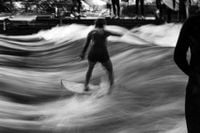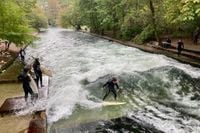For decades, the city of Munich has been home to an unlikely but iconic surfing destination: the Eisbachwelle, or "icy stream wave," a powerful man-made swell in the heart of the city’s English Garden park. Surfers from around the world have flocked to this urban marvel, braving the frigid waters of the Isar River for a chance to ride what SurferToday.com has dubbed "the mother of all river waves." But now, for the first time in generations, the wave has vanished—leaving surfers and city officials scrambling for answers and solutions.
The disappearance of the Eisbachwelle occurred after the city’s annual drainage and cleaning of the river basin late last week, a routine maintenance operation that, in theory, should have had no impact on the formation of the wave. As water was reintroduced into the stream on Friday, surfers and spectators alike waited in anticipation, only to be met with disappointment. Instead of the familiar, frothy surge, there was now only a simple, steady flow of water—useless for surfing and a far cry from the dramatic spectacle that once drew crowds to the bridge above.
"The many parameters that cause the wave in the water flow are being examined and adjusted accordingly," Mayor Dieter Reiter assured the public, according to statements reported by multiple outlets including SurferToday.com and The Independent. The city’s water authorities have begun measuring the flow and are experimenting with artificially raising water levels in hopes of coaxing the wave back into existence. "Using these results we will jointly establish how other redirection efforts can change water flow and volume levels, and how a surfable wave can be built up," the city government added.
The Eisbachwelle is no ordinary river wave. Born in 1972 when a group of pioneering surfers placed concrete blocks on the canal bed to manipulate the current, the wave quickly became a rite of passage for local and visiting riders. The powerful surge can reach heights of up to four feet (1.22 meters), and the average ride—thanks to the sheer force of the water—lasts less than a minute. Yet, for those precious seconds, surfers are transported far from the landlocked realities of Bavaria to a world of adrenaline and aquatic challenge.
The site’s popularity only grew over the years, with spectators regularly lining the bridge to watch surfers leap into the icy water, often in wetsuits—even in the depths of winter. Despite its renown, surfing at the Eisbachwelle was technically illegal until 2010, when the city finally sanctioned the activity, recognizing both its cultural significance and its draw for tourists. Munich, better known for Oktoberfest and its beer gardens, had quietly become a freshwater surfing capital.
Yet, the wave’s recent troubles are not entirely without precedent. Earlier in 2025, the Eisbachwelle was temporarily closed for renovations after tragedy struck: an experienced surfer died when her board leash became entangled with debris on the riverbed, pulling her underwater. The incident prompted city officials to introduce stricter safety regulations, including a ban on nighttime surfing. After these changes and the completion of renovation work, the wave had resumed its usual form by June, seemingly unscathed—until now.
The cause of the current disappearance remains stubbornly elusive. City authorities maintain that no modifications were made during the latest cleaning that should have disrupted the wave’s formation. Still, something has clearly changed beneath the surface. "At present there's a simple and steady flow of water of no use to surfing enthusiasts," reported SurferToday.com, echoing the frustration of the local community.
Surfers are not taking the loss lightly. Mathias Schmidt, representing the local surfers’ interest group IGSM, emphasized that both his organization and city authorities are working together to restore the wave. "The desire to recover the tourist trap had also motivated the Bavarian capital, not just local surfers," Schmidt explained, highlighting the wave’s importance to Munich’s identity—and economy. According to The Independent, the mayor’s office confirmed that surfers are now collaborating closely with the city’s building department, pooling expertise and passion in hopes of a breakthrough.
For many, the wave is more than just a sporting venue—it’s a community hub and a symbol of Munich’s open-mindedness. Lena Stillner, a Munich resident who has surfed the Eisbach for seven years, voiced the sentiments of many: "It's a shame the wave has disappeared and I hope the city will find a solution soon so we can return to the water." In the meantime, surfers have migrated to a second, less powerful wave elsewhere in the English Garden, but it’s simply not the same. The unique energy and challenge of the Eisbachwelle remain unmatched.
The phenomenon of river surfing, while unusual, is not unique to Munich. Other cities, including those in the United Kingdom and Hawaii, have their own traditions of riding standing waves in freshwater streams. However, the Eisbachwelle’s blend of urban accessibility, natural beauty, and cultural cachet set it apart. Its loss, even if temporary, is felt far beyond the local surfing scene.
As city engineers and surfers test various methods—adjusting water levels, redirecting flow, and perhaps even reconfiguring the canal bed—the broader Munich community watches with bated breath. The city’s tourism officials are acutely aware of the wave’s value, not just as a sporting curiosity but as a symbol of Munich’s adventurous spirit. The collaboration between government and grassroots organizations like IGSM is, in many ways, a testament to the city’s ability to unite in the face of a challenge.
Yet, the mystery persists. Was it an unnoticed shift in sediment? A subtle change in water pressure? Or something else entirely? For now, the answer remains hidden beneath the surface of the Isar, leaving both experts and enthusiasts to puzzle over what went wrong—and how to set it right.
What’s certain is that the Eisbachwelle has become more than just a wave; it’s a story of innovation, resilience, and community. As Munich’s authorities and surfers continue their efforts, the hope is that the icy surge will soon return, bringing with it the thrill, camaraderie, and sheer spectacle that have made the Eisbachwelle a legend in its own right.






